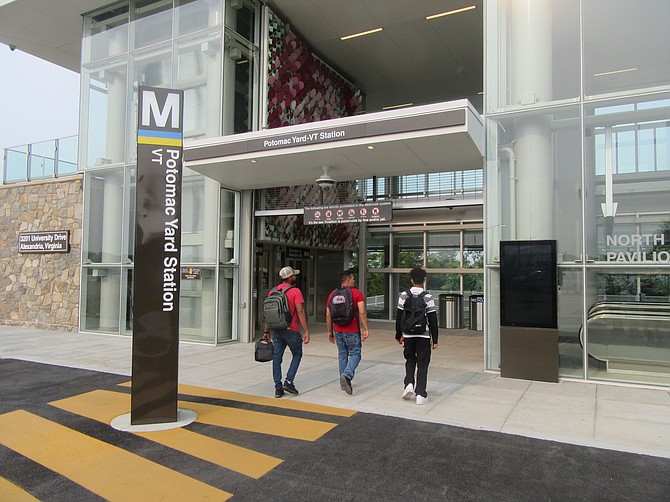Information
Potomac Yard-VT Station, https://www.wmata.com/rider-guide/stations/potomac-yard.cfm
Coalition for Smarter Growth, https://smartergrowth.net/
It’s smart and it’s special, stressed Stewart Schwartz, leading a walking tour of the new Potomac Yard-VT Metro subway station on June 6. Schwartz is the Coalition for Smart Growth’s Executive Director.
The station, which opened on May 19, is the Washington Metropolitan Area Transit Authority’s 98th and on the blue and yellow line in Alexandria between the Braddock Road and Reagan National Airport stations. Decades in the making, it was initiated by Alexandria and funded through tax revenue, developer contributions, federal and state grants, loans and regional sources.
It’s Smart
“The Coalition for Smarter Growth advocates passionately for projects like Potomac Yard because they create sustainable, livable urban communities with dedicated affordable housing close to jobs and opportunity,” said Bill Pugh, Senior Policy Fellow. He added, “This station improves travel options and will reduce miles of driving and greenhouse gas emissions compared to development in sprawling outer suburbs. The Potomac Yard station and mixed-use community will show how well-planned urban infill can foster vibrant communities and reduce climate emissions, while being sensitive to existing neighborhoods and our treasured parks and historic resources like the George Washington Memorial Parkway.”
The station has no commuter or Kiss and Ride parking, but has nearby DASH and Metroway bus stops, sidewalks, the Potomac Yard trail, bike parking and Capital Bikeshare. It will serve a burgeoning housing and commercial area.
Metro officials say that sustainability was a design focus and expect it to become one of the first rail stations in North America to receive Leadership in Energy and Environmental Design (LEED) silver certification from the U.S. Green Building Council.
To receive this designation, the surroundings must promote walkability and sustainable transportation. Managers must divert construction waste from landfills to recycling or reuse and manage stormwater runoff “to help preserve local wetlands,” says the WMATA website. They must use water-saving native plants and technology. State-of-the-art escalators, lighting, heating and air technologies should yield “reduced energy usage and carbon footprint.”
Virginia Tech is building its innovation campus just north of the station, today a rising edifice resembling a cruise ship. With the airport a stone’s throw away, the building’s design and shape are the maximum height and shape allowed by the Federal Aviation Administration to preserve flight sightlines, David Baker, Director of Operations explained to attendees.
Planned for a fall 2024 opening, the university will offer graduate level degrees in computer science and engineering and business administration, serving 1,000 full-time students a year plus researchers by 2028. The Potomac Yard station was a major draw, said Baker.
It's Special
Few rushing passengers pause to take in views, but the station has an observation deck offering expansive views looking north. “It’s one of the fun things” about the station, Schwartz told the group.
The otherwise steel-glass-concrete structure has artwork brightening up the two entrances, art that recognizes the station’s Virginia roots and the nation’s capital. The south pavilion features a representation of Virginia blue bells; on the north pavilion, cherry blossoms, both created by artist Rob Ley.
The design is intended to provide views that connect people to the natural environment. On the east side, riders can view a National Park Service wooded and wetland strip between the railroad tracks and the George Washington Memorial Parkway.
The station has public restrooms. Many Metro stations do not.
Some Locals Welcome It
Mount Vernonite Dave Wilson finds the station convenient for having after-work dinners and coordinating his doggie day care nearby. Another Mount Vernon resident, Amy Tryon, says, “It’s inspiring to see the brand new station. I’m glad to see Metro offering public transit to more people.” Kaiser Permanente patients welcome the convenience of going to appointments nearby without driving.
Not Without Controversy
The station site generated controversy during the permitting phase when local conservationists and others expressed concerns about adverse wetland impacts on National Park Service land. The 2019 U.S. Army Corps of Engineers permit to the city authorizes 3.5 acres of temporary and permanent impacts to wetlands. “Mitigation for the impacts would be accomplished by purchasing credits from the Buena Vista Wetland Mitigation Bank or an approved bank,” the permit states. It requires that some disturbed areas be “returned to preconstruction contours and replanted.”
Basics
The station has two entrances: the north at 3201 University Drive and the south at 3001 Potomac Avenue, both connected to the station by a covered walkway.
Potomac Yard Constructors, a joint venture of Halmar International and Schiavone Construction Company, built the station at a cost of $370 million. It sits on the former Richmond, Fredericksburg and Potomac railyard.
At the opening, local officials said it would generate billions in new private sector investment and support 26,000 new jobs. Alexandria Mayor Justin Wilson told reporters it will bring up to $2 million in new tax revenue to the city over 30 years, and 13,000 new residents.
U.S. Representative Don Beyer (VA-8) commented, "The completion of the Potomac Yard Metro Station is great news for the fastest growing area of Alexandria and will provide substantial benefits to Northern Virginia It took a determined effort to get here, and I commend the construction team, the involvement of residents, and the local, state and federal leaders who made this a reality."

